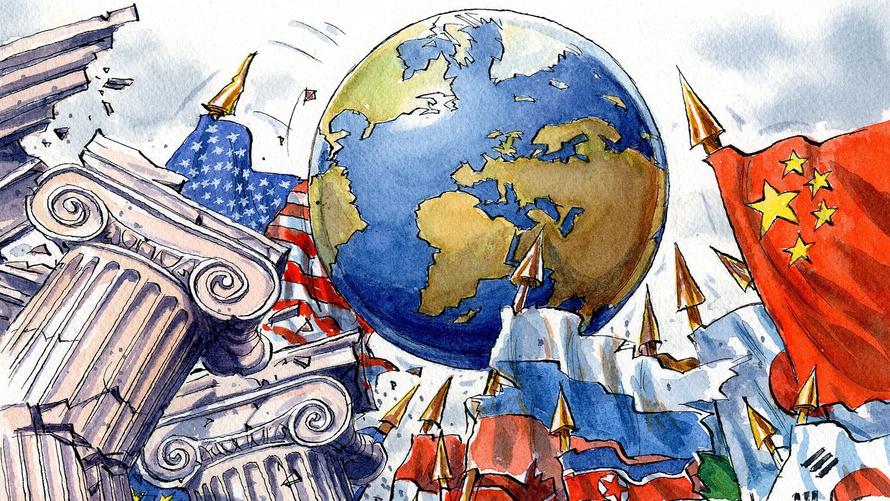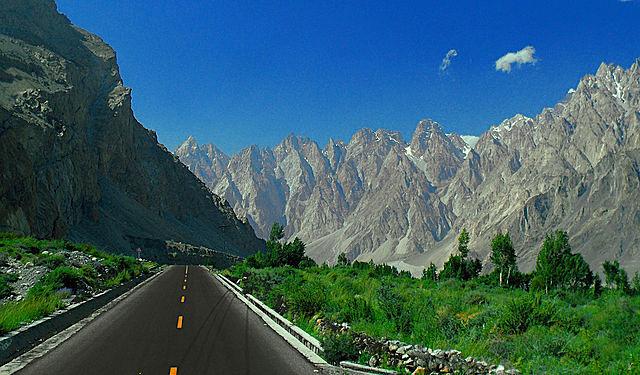Authored by Pepe Escobar via ConsortiumNews.com,
While China and Russia solidify their economic and political alliance, the U.S. is missing an historic chance to join a multilateral world, instead clinging to military empire…
We should know by now that the heart of the 21stCentury Great Game is the myriad layers of the battle between the United States and the partnership of Russia and China.
Even the U.S. National Defense Strategy says so: “The central challenge to U.S. prosperity and security is the reemergence of long-term, strategic competition by … revisionist powers.” The recently published assessment on U.S. defense implications of China’s global expansionsays so too.
The clash will frame the emergence of a possibly new, post-ideological, strategic world order amidst an extremely volatile unpredictability in which peace is war and an accident may spark a nuclear confrontation.
The U.S. vs. Russia and China will keep challenging the West’s obsession in deriding “illiberalism,” a fearful, rhetorical exercise that equates Russian democracy with China’s one party rule, Iran’s demo-theocracy and Turkey’s neo-Ottoman revival.
It’s immaterial that Russia’s economy is one-tenth of China’s. From boosting trade that bypasses the U.S. dollar, to increasing joint military exercises, the Russia-China symbiosis is poised to advance beyond political and ideological affinities.
China badly needs Russian know-how in its military industry. Beijing will turn this knowledge into plenty of dual use, civilian-military innovations.
The long game indicates Russia and China will break down language and cultural barriers to lead Eurasian integration against American economic hegemony backed by military might.
One could say the Eurasian century is already upon us. The era of the West shaping the world at will (a mere blip of history) is already over. This is despite Western elite denials and fulminations against the so-called “morally reprehensible,” “forces of instability” and “existential threats.”
Standard Chartered, the British financial services company, using a mix of purchasing power exchange rates and GDP growth, has projected that the top five economies in 2030 will be China, the U.S., India, Japan and Russia. These will be followed by Germany, Indonesia, Brazil, Turkey and the UK. Asia will extend its middle class as they are slowly killed off across the West.
Hop on the Trans-Eurasia Express
A case can be made that Beijing’s elites are fascinated at how Russia, in less than two decades, has returned to semi-superpower status after the devastation of the Yeltsin years.
That happened to a large extent due to science and technology. The most graphic example is the unmatched, state-of-the-art weaponry unveiled by President Vladimir Putin in his March 1, 2018speech.
In practice, Russia and China will be advancing the alignment of China’s New Silk Roads, or Belt and Road Initiative (BRI), with Russia’s Eurasia Economic Union (EAEU).
There’s ample potential for a Trans-Eurasia Express network of land and maritime transport corridors to be up and running by the middle of next decade, including, for instance, road and railway bridges connecting China with Russia across the Heilongjiang River.
Heilongjiang or Amur River separating China and Russia. (Wikimedia)
Following serious trilateral talks involving Russia, India and Iran last November, closer attention is being paid to the International North-South Transportation Corridor (INSTC), a 7,200-km long lane mixing sea and rail routes essentially linking the Indian Ocean with the Persian Gulf through Iran and Russia and further on down the road, to Europe.
Imagine cargo transiting from all over India to the Iranian port of Bandar Abbas, then overland to Bandar Anzali, an Iranian port on the Caspian Sea, and then on to the Russian southern port of Astrakhan, and after that to Europe by rail. From New Delhi’s point of view, that means shipping costs reduced by up to 40 percent, and Mumbai-to-Moscow in only 20 days.
Down the line, INSTC will merge with BRI – as in Chinese-led corridors linked with the India-Iran-Russia route into a global transport network.
This is happening just as Japan is looking at the Trans-Siberian Railway – which will be upgraded throughout the next decade – to improve its connections with Russia, China and the Koreas. Japan is now a top investor in Russia and at the same time very much interested in a Korea peace deal. That would free Tokyo from massive defense spending conditioned by Washington’s rules. The EAEU free trade agreements with ASEAN can be added to that.
Especially over these past four years, Russia has also learned how to attract Chinese investment and wealth, aware that Beijing’s system mass-produces virtually everything and knows how to market it globally, while Moscow needs to fight every block in the book dreamed up by Washington.
The Huawei-Venezuela “Axis of Evil”
Metal Truss Railroad Bridge (Kama River, near Perm city). Early color photograph from Russia, created by Sergei Mikhailovich Prokudin-Gorskii as part of his work to document the Russian Empire from 1909 to 1915. (Wikimedia)
While Washington remains a bipartisan prisoner to the Russophobic Platonic cave – where Cold War shadows on the wall are taken as reality – MAGA is missing the train to Eurasia.
A many-headed hydra, MAGA, stripped to the bone, could be read as a non-ideological antidote to the Empire’s global adventurism. Trump, in his non-strategic, shambolic way, proposed at least in theory the return to a social contract in the U.S. MAGA in theory would translate into jobs, opportunities for small businesses, low taxes and no more foreign wars.
It’s nostalgia for the 1950s and 60s before the Vietnam quagmire and before “Made in the USA” was slowly and deliberately dismantled. What’s left are tens of trillions of national debt; a quadrillion in derivatives; the Deep State running amok; and a lot of pumped up fear of evil Russians, devious Chinese, Persian mullahs, the troika of tyranny, the Belt and Road, Huawei, and illegal aliens.
More than a Hobbesian “war of all against all” or carping about the “Western rules-based system” being under attack, the fear is actually of the strategic challenge posed by Russia and China, which seeks a return to rule by international law.
MAGA would thrive if hitched to a ride on the Eurasia integration train: more jobs and more business opportunities instead of more foreign wars. Yet MAGA won’t happen – to a large extent because what really makes Trump tick is his policy of energy dominance to decisively interfere with Russia and China’s development.
The Pentagon and the “intel community” pushed the Trump administration to go after Huawei, branded as a nest of spies, while pressuring key allies Germany, Japan and Italy to follow. Germany and Japan permit the U.S. to control the key nodes in the extremities of Eurasia. Italy is essentially a large NATO base.
The U.S. Department of Justice requested the extradition of Huawei CFO Meng Wanzhou from Canada last Tuesday, adding a notch to the Trump administration’s geopolitical tactic of “blunt force trauma.”
Add to it that Huawei – based in Shenzhen and owned by its workers as shareholders – is killing Apple across Asia and in most latitudes across the Global South. The real the battle is over 5G, in which China aims to upstage the U.S., while upgrading capacity and production quality.
The digital economy in China is already larger than the GDP of France or the UK. It’s based on the BATX companies (Baidu, Alibaba, Tencent, Xiaomi), Didi (the Chinese Uber), e-commerce giant JD.com and Huawei. These Big Seven are a state within a civilization – an ecosystem they’ve constructed themselves, investing fortunes in big data, artificial intelligence (AI) and the internet. American giants – Facebook, Instagram, Twitter and Google – are absent from this enormous market.
Moreover, Huawei’s sophisticated encryption system in telecom equipment prevents interception by the NSA. That helps account for its extreme popularity all across the Global South, in contrast to the Five Eyes (U.S., UK, Canada, Australia, New Zealand) electronic espionage network.
The economic war on Huawei is also directly connected to the expansion of BRI across 70 Asian, European and African nations, constituting a Eurasia-wide network of commerce, investment and infrastructure able to turn geopolitical and geo-economic relations, as we know them, upside down.
Greater Eurasia Beckons
Whatever China does won’t alter the Deep State’s obsession about “an aggression against our vital interests,” as stated by the National Defense Strategy. The dominant Pentagon narrative in years to come will be about China “intending to impose, in the short term, its hegemony in the Indo-Pacific region, and catch the United States off-guard in order to achieve future global pre-eminence.” This is mixed with a belief that Russia wants to “crush NATO” and “sabotage the democratic process in Crimea and Eastern Ukraine.”
The Karakoram Highway connecting China and Pakistan, sometimes referred to as the Eighth Wonder of the World.(Wikimedia)
During my recent travels along the northern part of the China-Pakistan Economic Corridor (CPEC), I saw once again how China is upgrading highways, building dams, railways and bridges that are useful not only for its own economic expansion but also for its neighbors’ development. Compare it to U.S. wars – as in Iraq and Libya – where dams, railways and bridges are destroyed.
Russian diplomacy is all but winning the New Cold War — as diagnosed by Prof. Stephen Cohen in his latest book, War with Russia: From Putin and Ukraine to Trump and Russiagate.
Moscow mixes serious warnings with diverse strategies, such as resurrecting the South Stream gas pipeline to supply Europe as an extension of Turk Stream after the Trump administration also furiously opposed the Nord Stream 2 pipeline with sanctions on Russia. Meanwhile, Moscow ramps up energy exports to China.
The advance of the Belt and Road Initiative is linked to Russian security and energy exports, including the Northern Sea Route, as an alternative future transportation corridor to Central Asia. Russia emerges then as the top security guarantee for Eurasian trade and economic integration.
Last month in Moscow, I discussed Greater Eurasia– by now established as the overarching concept of Russian foreign policy – with top Russian analysts. They told me Putin is on board. He referred to Eurasia recently as “not a chessboard or a geopolitical playground, but our peaceful and prosperous home.”
Needless to say, U.S. think tanks dismiss the idea as “abortive”. They ignore Prof. Sergey Karaganov, who as early as mid-2017 was arguing that Greater Eurasia could serve as a platform for “a trilateral dialogue on global problems and international strategic stability between Russia, the United States and China.”
As much as the Beltway may refuse it, “The center of gravity of global trade is now shifting from the high seas toward the vast continental interior of Eurasia.”
Beijing Skirts the Dollar
Beijing is realizing it can’t meet its geo-economic goals on energy, security, and trade without bypassing the U.S. dollar.
According to the IMF, 62 percent of global central bank reserves were still held in U.S. dollars by the second quarter of 2018. Around 43 per cent of international transactions on SWIFT are still in U.S. dollars. Even as China, in 2018, was the single largest contributor to global GDP growth, at 27.2 percent, the yuan still only accounts for 1 percent of international payments, and 1.8 per cent of all reserve assets held by central banks.
It takes time, but change is on the way. China’s cross-border payment network for yuan transactions was launched less than four years ago. Integration between the Russian Mir payment system and Chinese Union Pay appears inevitable.
Bye Bye Drs. K and Zbig
Russia and China are developing the ultimate nightmare for those former shamans of U.S. foreign policy, Henry Kissinger and the late Zbigniew “Grand Chessboard” Brzezinski.
Back in 1972 Kissinger was the mastermind – with logistical help from Pakistan – of the Nixon moment in China. That was classic Divide and Rule, separating China from the USSR. Two years ago, before Trump’s inauguration, Dr. K’s advice dispensed at Trump Tower meetings consisted of a modified Divide and Rule: the seduction of Russia to contain China.
The Kissinger doctrine rules that, geopolitically, the U.S. is just “an island off the shores of the large landmass of Eurasia.” Domination “by a single power of either of Eurasia’s two principal spheres – Europe or Asia – remains a good definition of strategic danger for America, Cold War or no Cold War,” as Kissinger said. “For such a grouping would have the capacity to outstrip America economically and, in the end, militarily.”
The Zbig doctrine ran along similar lines. The objectives were to prevent collusion and maintain security among the EU-NATO vassals; keep tributaries pliant; keep the barbarians (a.k.a. Russians and allies) from coming together; most of all prevent the emergence of a hostile coalition (as in today’s Russia-China alliance) capable of challenging U.S. hegemony; and submit Germany, Russia, Japan, Iran, and China to permanent Divide and Rule.
Thus the despair of the current National Security Strategy, forecasting China displacing the United States “to achieve global preeminence in the future,” through BRI’s supra-continental reach.
The “policy” to counteract such “threats” is sanctions, sanctions, and more unilateral sanctions, coupled with an inflation of absurd notions peddled across the Beltway – such as that Russia is aiding and abetting the re-conquest of the Arab world by Persia. Also that Beijing will ditch the “paper tiger” “Made in China 2025” plan for its major upgrade in global, high-tech manufacturing just because Trump hates it.
Once in a blue moon a U.S. report actually gets it right, such as in Beijing speeding up an array of BRI projects; as a modified Sun Tzu tactic deployed by President Xi Jinping.
At the June 2016 Shangri-La Dialogue in Singapore, Professor Xiang Lanxin, director of the Centre of One Belt and One Road Studies at the China National Institute for SCO International Exchange and Judicial Cooperation, defined BRI as an avenue to a “post-Westphalian world.” The journey is just beginning; a new geopolitical and economic era is at hand. And the U.S. is being left behind at the station.
via ZeroHedge News http://bit.ly/2UDyglx Tyler Durden



